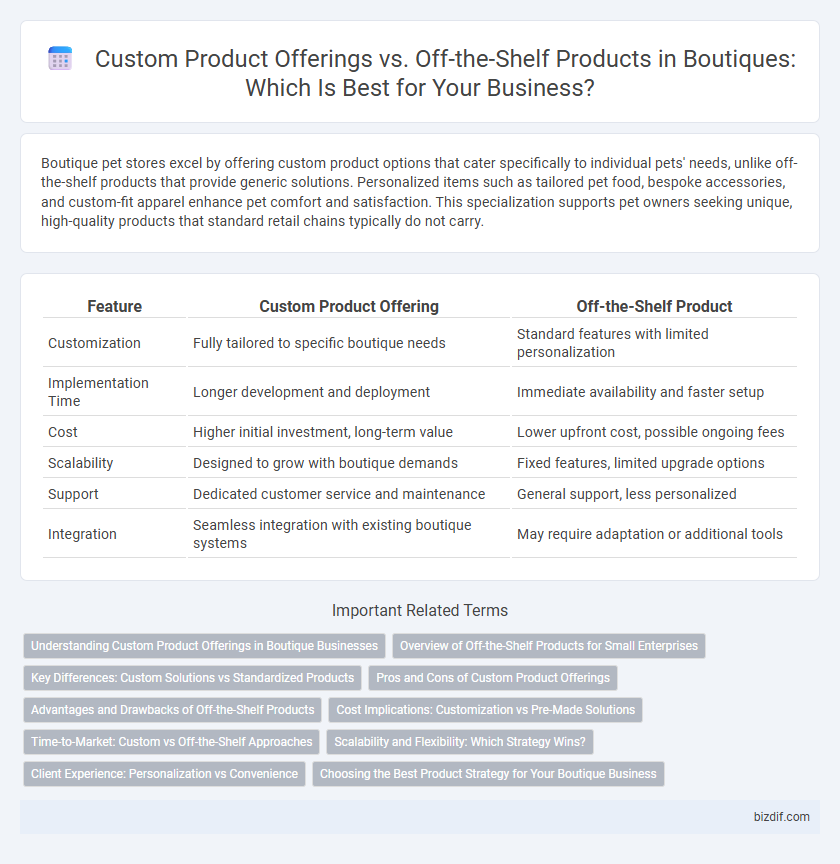Boutique pet stores excel by offering custom product options that cater specifically to individual pets' needs, unlike off-the-shelf products that provide generic solutions. Personalized items such as tailored pet food, bespoke accessories, and custom-fit apparel enhance pet comfort and satisfaction. This specialization supports pet owners seeking unique, high-quality products that standard retail chains typically do not carry.
Table of Comparison
| Feature | Custom Product Offering | Off-the-Shelf Product |
|---|---|---|
| Customization | Fully tailored to specific boutique needs | Standard features with limited personalization |
| Implementation Time | Longer development and deployment | Immediate availability and faster setup |
| Cost | Higher initial investment, long-term value | Lower upfront cost, possible ongoing fees |
| Scalability | Designed to grow with boutique demands | Fixed features, limited upgrade options |
| Support | Dedicated customer service and maintenance | General support, less personalized |
| Integration | Seamless integration with existing boutique systems | May require adaptation or additional tools |
Understanding Custom Product Offerings in Boutique Businesses
Boutique businesses excel by delivering custom product offerings tailored to individual customer preferences, enhancing uniqueness and customer satisfaction. Unlike off-the-shelf products, these personalized items leverage direct client input, ensuring exclusivity and a perfect fit for specific needs. Custom product offerings drive higher perceived value and brand loyalty, positioning boutiques as preferred destinations for bespoke shopping experiences.
Overview of Off-the-Shelf Products for Small Enterprises
Off-the-shelf products provide small enterprises with immediate access to standardized solutions designed for broad market use, ensuring cost efficiency and faster deployment. These products often come with established support structures, regular updates, and proven reliability, reducing the need for extensive customization or technical expertise. While customization options are limited, off-the-shelf offerings enable small businesses to quickly implement essential tools and services without the delays and expenses associated with bespoke solutions.
Key Differences: Custom Solutions vs Standardized Products
Custom product offerings in boutiques are tailored to meet specific client preferences, leveraging unique materials, personalized design, and bespoke craftsmanship that cater to individual lifestyle and taste. Off-the-shelf products provide standardized, mass-produced items available immediately, emphasizing consistency, affordability, and broad market appeal. The key differences lie in customization level, production scale, and exclusivity, with custom solutions delivering unique value and higher price points compared to accessible standard products.
Pros and Cons of Custom Product Offerings
Custom product offerings in boutiques provide personalized options tailored to individual customer preferences, enhancing satisfaction and brand loyalty. These products typically justify premium pricing but require longer production times and higher resource investment. The customization process can limit scalability and increase complexity in inventory management compared to off-the-shelf products.
Advantages and Drawbacks of Off-the-Shelf Products
Off-the-shelf products offer immediate availability and lower upfront costs, making them ideal for boutiques seeking quick inventory solutions without extensive customization. However, these products often lack uniqueness and may not align perfectly with the brand identity or specific customer preferences. Limited flexibility and potential overlap with competitors using the same items can hinder differentiation in a competitive boutique market.
Cost Implications: Customization vs Pre-Made Solutions
Custom product offerings in boutiques typically involve higher upfront costs due to personalized design, sourcing unique materials, and extended production timelines. Off-the-shelf products benefit from economies of scale, resulting in lower prices and faster availability but may lack tailored features and exclusivity. Evaluating cost implications requires balancing customization expenses against the value of unique customer experiences and brand differentiation.
Time-to-Market: Custom vs Off-the-Shelf Approaches
Custom product offerings in boutiques often require longer development cycles due to personalized design and craftsmanship, impacting time-to-market significantly. Off-the-shelf products provide immediate availability, allowing boutiques to quickly meet customer demand and trends. Balancing bespoke quality with rapid inventory turnover is critical for maintaining competitive advantage in the boutique retail sector.
Scalability and Flexibility: Which Strategy Wins?
Custom product offerings provide unparalleled scalability by allowing boutiques to tailor inventory and services precisely to customer demand, optimizing resource allocation and minimizing waste. Off-the-shelf products, while less flexible, offer immediate availability and proven market appeal, enabling rapid scaling without extensive development costs. For boutiques prioritizing adaptability and personalized customer experiences, custom solutions generally deliver superior flexibility, whereas off-the-shelf products excel in fast, cost-effective scalability.
Client Experience: Personalization vs Convenience
Custom product offerings in boutiques enhance client experience by delivering tailored solutions that reflect individual preferences, fostering emotional connection and brand loyalty. Off-the-shelf products prioritize convenience and immediate availability, catering to customers seeking quick and straightforward purchasing decisions. Personalized services in custom offerings often result in higher satisfaction and repeat business compared to the standardized experience of off-the-shelf options.
Choosing the Best Product Strategy for Your Boutique Business
Custom product offerings enable boutiques to tailor unique items that reflect their brand identity and customer preferences, fostering stronger loyalty and higher perceived value. Off-the-shelf products provide immediate inventory solutions with proven market demand, reducing lead times and minimizing production costs. Evaluating your boutique's target market, budget constraints, and brand positioning is essential to select a product strategy that maximizes profitability and competitive advantage.
Custom Product Offering vs Off-the-Shelf Product Infographic

 bizdif.com
bizdif.com